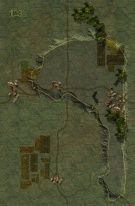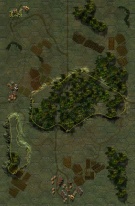|
Total |
| Side 1 |
0 |
| Draw |
0 |
| Side 2 |
2 |
|
Total |
| Side 1 |
0 |
| Draw |
0 |
| Side 2 |
2 |
|
Total |
| Side 1 |
0 |
| Draw |
0 |
| Side 2 |
0 |
| Overall Rating, 2 votes |
|---|
|
|
|
Scenario Rank:
--- of 913 |
| Parent Game |
Road to Dunkirk |
| Historicity |
Historical |
| Date |
1940-05-27 |
| Start Time |
09:00 |
| Turn Count |
12 |
| Visibility |
Day |
| Counters |
37 |
| Net Morale |
1 |
| Net Initiative |
2 |
| Maps |
2: 123, 124 |
| Layout Dimensions |
56 x 43 cm
22 x 17 in |
| Play Bounty |
151 |
| AAR Bounty |
227 |
| Total Plays |
2 |
| Total AARs |
0 |
|
Introduction
|
|
The Queen’s Bays regiment (2nd Dragoon Guards) was 250 years old and one of the oldest Crown regiments. Evolving from a traditional horse cavalry unit, the regiment had become fully armored even if that conversion was not so well accepted. During the early approach to the Somme River, the Bays, supported by a few French troops, constituted the easternmost column but they fared little better than the Hussars at Huppy. As the lead squadron passed over the crest of a gently sloping ridge at Bailleul through a thin line of French riflemen, they met a hail of heavy machine gun and anti-tank fire from strong enemy positions in the woods north of Limeux. Silhouetted against the skyline, their tanks presented perfect targets for the Germans dug in on the other side of the valley.
|
|
Conclusion
|
|
The four leading tanks were hit in the first few minutes. Moving to the east to try to outflank the enemy proved impossible – German shells found their targets with unnerving accuracy and caused great damage. The Bays soon launched another attack to test the position but their tanks were again stopped dead in their tracks despite impressive support from the French guns. The enemy was simply too strong. The Bays’ diary ruefully notes: It has been impossible to do little more than locate the enemy positions and at considerable cost.
|
Display Relevant AFV Rules
| AFV Rules Pertaining to this Scenario's Order of Battle |
- Vulnerable to results on the Assault Combat Chart (7.25, 7.63, ACC), and may be attacked by Anti-Tank fire (11.2, DFT). Anti-Tank fire only affects the individual unit fired upon (7.62, 11.0).
- AFV's are activated by tank leaders (3.2, 3.3, 5.42, 6.8).
They may also be activated as part of an initial activating stack, but if activated in this way would need a tank
leader in order to carry out combat movement.
- AFV's do not block Direct Fire (10.1).
- Full-strength AFV's with "armor efficiency" may make two anti-tank (AT) fire attacks per turn
(either in their action segment or during opportunity fire) if they have AT fire values of 0 or more
(11.2).
- Each unit with an AT fire value of 2 or more may fire at targets at a distance of between 100% and 150% of its
printed AT range. It does so at half its AT fire value. (11.3)
- Efficient and non-efficient AFV's may conduct two opportunity fires per turn if using direct fire
(7.44, 7.64).
Units with both Direct and AT Fire values may use either type of fire in the same turn as their opportunity fire,
but not both (7.22, 13.0).
Units which can take opportunity fire twice per turn do not have to target the same unit both times (13.0).
- Demoralized AFV's are not required to flee from units that do not have AT fire values (14.3).
- Place a Wreck marker when an AFV is eliminated in a bridge or town hex (16.3).
- AFV's do not benefit from Entrenchments (16.42).
- AFV's may Dig In (16.2).
- Closed-top AFV's: Immune to M, M1 and M2 results on Direct and Bombardment Fire Tables. Do not take step losses from Direct or Bombardment Fire. If X or #X result on Fire Table, make M morale check instead (7.25, 7.41, 7.61, BT, DFT).
- Closed-top AFV's: Provide the +1 modifier on the Assault Table when combined with infantry. (Modifier only applies to Germans in all scenarios; Soviet Guards in scenarios taking place after 1942; Polish, US and Commonwealth in scenarios taking place after 1943.) (ACC)
- Tank: all are closed-top and provide the +1 Assault bonus, when applicable
- Armored Cars: These are Combat Units. They are motorized instead of mechanized. All have their own armored car leaders, who can only activate armored cars (6.85). Do not provide the +1 Assault bonus (ACC).
- Reconnaissance Vehicle: 8.23 Special Spotting Powers Both foot and vehicle mounted recce units (1.2) possess two special spotting abilities. The first ability is that they can spot enemy in limiting terrain at one hex further than the TEC specifies for other units and leaders. For example, an enemy unit in town can normally be spotted at three hexes or less, but a recce unit can spot them at four hexes.Their second ability is that they can place a Spotted marker on any one enemy unit they can spot per turn, just as if the enemy unit had "blown its cover" by firing. Such Spotted markers are removed as described earlier.
|
| 2 Errata Items |

|
In 1940: Fall of France, the units show Direct Fire. All units are Indirect Fire.
|

|
The reduced direct fire value of the Heer HMG became 5-5 starting with Fall of France.
|




 RtDk015
RtDk015 


















